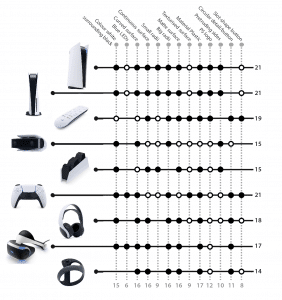By Amanda Djäknegren
As a part of the course “PPU101 Form and manufacturing case studies” at Chalmers I performed a case study, where the goal was to take inspiration from the properties (both possibilities and restrictions) of wooden materials when creating a drafting lamp suited for a home office. Additionally, the product was supposed to fit into the PlayStation 5 product series and brand. The wooden lamp uses the unique attributes of wood in order to bend it using a lattice joint, used in the upper hinge. Prior to the development, a Design Format Analysis was performed to understand the brand. Additionally, a Competitor Analysis and a Literature Study on drafting lamps were performed to understand what creates a good drafting lamp for home-use. The concept was developed using the Fish-trap model to create a wide variety of alternatives in a short period of time, and changes were made according to the Design Failure Mode and Effects Analysis which ensures potential design issues are fixed early in the process.
The final design of the drafting lamp has a light that’s 50 cm long, and clamps onto the table which allows it to take up less space. Right above the clamping solution is one of the two hinges featured in the product, which can be fastened and loosened by turning the slot-shaped handle. The second hinge seen further up on the lamp is a lattice hinge which allows the user to adjust the angle of the light both up and down and side to side. This hinge is created by cutting slits in the wood from above and below, creating a flexible joint which doesn’t interrupt the overall aesthetic of the lamp. This allows the light’s position to be extensively adjusted according the user’s needs.
The lamp is made out of a combination of light and dark wood, which reflects the white and black aesthetic of the PlayStation 5 product series. The light wood is birch which is placed around the light source directs the light downwards and prevents glare from the light. The dark wood is walnut which is stained to further achieve the PlayStation-black look, and protects
One of the most important parts of the drafting lamp is the light itself. The light is 50 cm long, which according to the test which were made (described in the process below), sufficiently lights up the desk and spreads the light evenly across it, especially the desk pad. The light is made out of an array of LEDs covered by a translucent sheet which diffuses the light. In combination with the length of the light, this creates a very even, all but shadow-free surface.
Process

The brand and series of products I chose to work with was Sony’s Playstation 5 series of products since I find them to have a unique and interesting design language. The design language was explored using a Design Format Analysis in order to understand the products part of the Playstation 5 lineup – which features are the most important in creating a product that looks like a product from the fifth generation PlayStation series of products, and also which products are the most identifiable as PlayStation products.
Before creating a lamp, a literature study was conducted to understand the importance of colour temperature, Colour Rendering Index, illuminance and other relevant concepts applicable for drafting lights.

To be able to prototype how the drafting lamp fits into its context, a Fusion 360 model of a home office (more specifically my home office) was modelled. This room was judged to be representative of a home office since it’s a small room with general lighting that is more suitable for a bedroom than an office, as many home offices are transformed from a bedroom into an office. All bigger furniture including their material, colour and reflectance was recreated as accurately as possible so that the light in the room is as true to life as possible. The light in the virtual room was adjusted until it matched to the real room as good as possible.
In order to understand how the width of the light affects the light distribution on the desk, a mock-up study was performed. The pictures were taken at noon with a set exposure, white balance, and shutter time. Part of the light was initially covered, and the cover was gradually removed in order to evaluate light sources with a length between 27-85 cm, which was based on the competitor analysis. The exposure and shutter time was set using the automatic settings of the camera when the light was 27 cm long. The subsequent images where the cover was gradually removed are therefore severely overexposed, but this clearly shows how much the length of the light affects the illuminance (lux = lumen/m^2) of the surface, and how much of the desk is being lit up.

In order to generate a large number of alternatives in a short amount of time, the Fish-trap model was used. In the topological step, the relation between the basic structures were examined. In this case the relation between the light source and the table was the most important, since it’s important that the light source is centered over the working surface in order to create an evenly lit surface. In the typological step, the arm that connects the base to the light was explored further. The morphological step was conducted in Fusion 360 where the formal concept first was created and then modified in an iterative fashion.

Typological variants
The concept was scrutinised using a Design Failure Mode and Effect Analysis in order to find issues in the design that may cause problems in production. The changes implemented due to this method are this time not visible on the exterior of the lamp, but will make sure the lamp will hold up structurally over time through reinforcement of joints.









